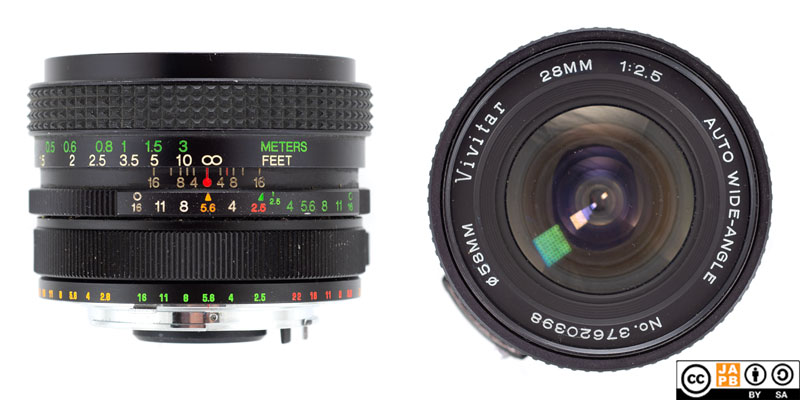Pekka Buttler, 03/2024

Specifications
The table below summarizes the lens’ key specifications (measurements based on pictured, last version of the lens):
| Brand: | Vivitar | Lens name | 28MM 1:2.5 auto wide-angle |
| Focal length(s)1 | 28 mm | Angle-of-view2 | 74° |
| Maximum Aperture | f/2.5 | In Production | ca. 1976–1980 |
| Lens mount (this lens) | Nikon F (Ai) | Other lens mounts | multiple3 (TX) |
| Length4 | 46,2 mm (with Nikon F adapter) 40,7 mm (bare TX mount) | Diameter54 | 66,7 mm |
| Filter ring diameter | 58 mm | Weight | 286 grams |
| Lens element count | unclear6 | Lens group count | unclear |
| Aperture blades (S/R/C)7 | 8 S | Focus throw | 160 ° |
| Minimum focusing distance | 25 cms | Maximum magnification | 1:6,2 |
| Has manual aperture ring | YES | Has Manual focus ring | YES |
| Aperture mechanism type | Automatic | Aperture click stops 8 | 2.8-4-5.6-8-11-16 |
Further notes:
• With a ’37xxx’ serial number prefix, this is a lens originally manufactured by Tokina. Significantly, Tokina never manufactured this lens for themselves or any other rebrander. Resultingly, finding trustworthy data on the optical design of the lens is difficult.
• There are several different lenses that Vivitar sold that shared the same mainline specifications, namely a 28 mm focal length and an f/2.5 maximum aperture. However, none of the other lenses are in any way related to this lens.
Versions and variations
While Vivitar seems to have sold a number of different 28 mm lenses with an f/2.5 maximum aperture, none of those other lenses are related to this lens in any meaningful way. Moreover, I have found no indication that Tokina would ever have sold this design under its own brand, nor to any other rebrander. Furthermore, I have not found any indication of more than one cosmetic version of this lens.
However, this Vivitar 28 mm f/2.5 was offered using a TX intermediate mount, and – hence – a wide range of end-user mounts. This in itself leads to some variation (with the difference in flange focal differences ranging from 40,5 mm to 46,5 mm). Hence the length of the Vivitar 28 mm f/2.5 will vary somewhat based on which lens mount it has, and the different lens mounts will unavoidably also lead to some cosmetic differences.
History of Vivitar
Vivitar initially was the trade name used by Ponder & Best Inc. until Ponder & Best changed its name to Vivitar Corp. From the 1960s to the early 2000s the company contracted various (mostly Japanese) optical and electronics manufacturers to manufacture photographic gear to be branded as Vivitar.
You can read more details in the Vivitar company profile.
Adapting
n.B! The following applies to all Ai and Ai-s type Nikon F mount lenses.
Besides adapting, this lens can be used natively on all current high-end Nikon dSLRs and several earlier medium-to-high-end older Nikon dSLRs7. Likewise, if it still has its rabbit ears, it can be natively used on all Nikon F-mount film cameras ever produced (without the rabbit ears, it is limited to post 1977 bodies).
Thanks to being a fully manual lens (manual aperture, manual focus), the lens can be adapted to all mirrorless cameras using a suitable dumb adapter (and such adapters are easy to find). Moreover, a large range of special adapters (helicoid adapters, tilt/shift adapters, speed boosters) for using Nikon F lenses on most mirrorless systems are available.
Using Nikon F lenses on non-Nikon SLRs and dSLRs is likewise a distinct possibility. Thanks to the relatively generous flange focal distance of the Nikon F mount (46,5 mm), adapter rings for all dSLR mounts are available as well as for a goodly portion of film-era SLR mounts. Such rings may not allow for auto aperture, but even then the lenses can be used in stop-down metering mode.
Footnotes
- Focal length is (unless stated otherwise) given in absolute terms, and not in Full-frame equivalent. For an understanding of whether the lens is wide/tele, see ‘Angle-of-view’. ↩︎
- Picture angle is given in degrees (based on manufacturers’ specs) and concerns the diagonal picture angle. Rule of thumb:
> 90 ° ==> Ultra-wide-angle
70–90 ° ==> Wide-angle
50–70 ° ==> Moderate wide-angle
40–50 ° ==> ‘Standard’ or ‘normal’ lens
20–40 ° ==> Short tele lens
10-20 ° ==> Tele lens
5-10 ° ==> Long tele lens
< 5 ° ==> Ultra-tele lens ↩︎ - Any lens mount for which there is a TX-adapter, including: Canon FD, Contax/Yashica, Konica AR, M42, Minolta SR, Nikon F, Olympus OM and Pentax K ↩︎
- Length is given from the mount flange to the front of lens at infinity. ↩︎
- Diameter excludes protrusions such as rabbit ears or stop-down levers. ↩︎
- Online sources are few and far between and offer conflicting data. Some mention a 8 elements in 8 groups design, others a 9 elements in 7 groups design. ↩︎
- S=straight; R=rounded; C=(almost)circular at all apertures. ↩︎
- Numbers equal aperture values on aperture ring; • intermediate click; – no intermediate click. ↩︎